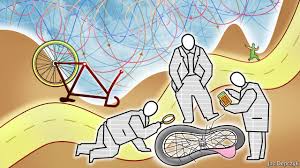Economists still lack a proper understanding of business cycles

THE aftermath of the 2007-08 financial crisis ought to have been a moment of triumph for economics. Lessons learned from the 1930s prevented the collapse of global finance and trade, and resulted in a downturn far shorter and less severe than the Depression. But even as the policy remedies were helpful, the crisis exposed the economic profession’s continued ignorance of the business cycle. That is bad news not just for the discipline, but for everyone.
The aim of those studying the macroeconomy has always been to understand the economy’s wobbles, and to work out when governments should intervene. That is not easy. Downturns come often enough to be a serious irritant, but not often enough to give economists sufficient data for rigorous statistical analysis. It is hard to distinguish between short-run swings and structural economic changes resulting from demography or technology. Most classical economists were sceptical of the idea that the macroeconomy needed much oversight at all.
By the early 20th century some thinkers were groping their way towards a better understanding of money in the economy, and how its mismanagement could cause problems. The Depression forced non-interventionists to concede ground. John Maynard Keynes blamed recessions on a shortfall of demand linked to changes in saving and investment behaviour. Governments used both monetary and fiscal policy with gusto in the years after the second world war to maintain full employment.
Yet the Keynesians’ heavy-handed approach never sat well with classically minded economists. In 1963 Milton Friedman and Anna Schwartz published their “Monetary History of the United States”, which resurrected the pre-Depression “monetarist” view that monetary stability can mend all macroeconomic ills. Other economists, including Edmund Phelps and Robert Lucas, recognised that people learn to anticipate policy changes and adjust their behaviour in response. They predicted that sustained stimulus would eventually cause inflation to accelerate and were vindicated by runaway price growth in the 1970s.
In the years that followed, Keynesians regrouped, borrowed ideas from their critics and built “New Keynesian” models (on which much modern forecasting is based). The synthesis of Keynesian and neoclassical ideas informed a new approach to managing the business cycle. The job was outsourced to central bankers, who promised to keep a lid on inflation. Adopted around the world, this approach seemed to work. Downturns became less frequent and less severe; inflation was low and stable; expansions became longer.
But all was not well. Many neoclassical economists rejected the “New Keynesian consensus” and worked along separate lines. Some followed their models back to the classical idea that fluctuations were natural and required no intervention. That occasionally led to absurd conclusions, for instance that falling inflation in the early 1980s had almost nothing to do with monetary policy. Although central banks largely ignored this work, its leading theorists retained influence within the profession—winning Nobel prizes, for example—and with conservative politicians.
The New Keynesians had their own troubles. To satisfy critics they built more mathematical models, which aimed to show how decisions by rational, forward-looking people could, in aggregate, cause downturns. The project was quixotic. People are often irrational. Their behaviour in groups is not as predicted by models that treat the economy as a mass of identical individuals. These models were complex enough to be fitted to almost any story. They could replicate features of the economy, but that did not amount to understanding why those features occurred.
The gap between many neoclassical economists and the New Keynesians running central banks remained unbridgeable. As Paul Romer has pointed out in some scathing recent papers, the rival camps were unable to settle their arguments by appealing to facts, or even to debate politely. You might suppose that the existence of wildly different business-cycle theories would make macroeconomists more humble, but no. Improbably, both groups argued that, in the words of Professor Lucas, the “central problem of depression-prevention has been solved”.
The return of depressing economics
Where consensus did prevail, it proved to be misguided. Economists of all ideological stripes cheered on the financial deregulation of the 1980s and 1990s. The work of thinkers like Hyman Minsky and Charles Kindleberger, whose writings on financial excess were rediscovered after the financial crisis, gathered dust. In a speech in 2005 to central bankers, Raghuram Rajan, an academic who later ran India’s central bank, warned of the risks building within the financial system. He got a chilly reception.
There has been progress since the crisis. New research questions the old orthodoxy on matters from the appropriate role of fiscal policy and the risks associated with large-scale financial flows to the relationship between unemployment and inflation. But the profession remains in a dangerous and unsustainable position. The macroeconomic approach favoured by economists within central banks, regulatory agencies and finance ministries has erred repeatedly in its prognostications over the past decade, predicting that labour markets would heal quickly, for example, while underestimating the risks of targeting a low rate of inflation. A compelling new paradigm seems a distant prospect. Nor is it clear economists are capable of sorting out their disagreements. Macroeconomics must get to grips with its epistemological woes if it hopes to maintain its influence and limit the damage done by the next crisis. Because economists have learned one thing: there is always another crisis.
This article appeared in the Finance and economics section of the print edition under the headline “Diminished expectations”





